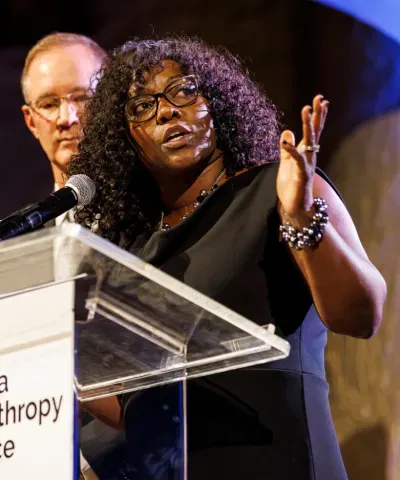Building Bridges That Hold: Aligning Government, Philanthropy, and Advocacy
Across the arc of my career, one image helps explain what I’ve come to understand about the role of government, philanthropy, and policy advocacy: a bridge.

30 April 2025
A Familiar Refrain:
“We are living in unprecedented times.”
“Business as usual isn’t going to cut it anymore; we need to be creative, nimble, and adaptive.”
“The stakes couldn’t be higher. Real lives are dependent on our response.”
These are all statements I thought, uttered, or heard as a state government employee when the COVID-19 pandemic burst onto the world scene. We are now, incredibly, five years removed from those early days when we commuted from the bedroom to the kitchen table, clumsily learned virtual platforms, and filled after-work hours with sourdough or Tiger King. Yet I still feel the weight of responsibility that came with keeping essential services running. As public servants, it was up to my coworkers and me to help protect Hoosiers’ mental, emotional, and physical wellbeing—especially the most vulnerable.
Much has changed since 2020. My kids, who were in preschool and kindergarten then, have only hazy memories of lockdown and are now headed to third grade and middle school. I’ve moved from public service to the community development sector. Life has marched on.
And yet, in recent months, I’ve heard those same three statements again—not from the halls of government, but from the nonprofit sector.
Different context, same urgency. The familiar tug of responsibility is back, this time as my colleagues and I work to respond to deepening community needs amid cuts to public services.
Bridging the Gap and Checking for Cracks
Across the arc of my career, one image helps explain what I’ve come to understand about the role of government, philanthropy, and policy advocacy: a bridge.
- Government is the main structure of the bridge: solid, publicly funded, designed to carry everyone safely over life’s rough patches (poverty, illness, job loss).
- Philanthropy is the scaffolding and maintenance crew: patching holes, testing new materials, reinforcing weak spots.
- Policy advocacy is the engineer and inspector: making sure the bridge is safe, functional, and built for all travelers, not just a privileged few.
The government plays a mandated role in providing safety net services, backed by legislation and funded by taxpayers. These services are consistent and broad-reaching, with built-in accountability. But public systems can be slow to adapt, constrained by bureaucracy and shifting political will. And they don’t always catch everyone.
Philanthropy steps in to bridge those gaps. I’ve heard it called the “safety net to the safety net.” It can respond more quickly, fund innovation, and support populations that public systems may overlook. But philanthropic resources are often limited, fragmented, and shaped by donor priorities. Without public-sector partnership, they risk being unsustainable.
Together, government and philanthropy form a hybrid safety net. But for it to work well, alignment and collaboration are essential. Government provides structure and scale; philanthropy adds agility and responsiveness. The best outcomes come when the two work in tandem.
But what happens when a commuter bridge is built where pedestrians need to cross? Even the most impressive structure can fail if it wasn’t built with everyone in mind. In these moments, advocacy becomes essential by shaping systems not just to function, but to serve everyone they’re meant to support.
Advocacy pushes systems to be not just operational, but functional for all. It ensures that programs serve everyone, not just those easiest to reach. Without advocacy, systems drift toward imbalance, inefficiency, or irrelevance. With it, we can help public and philanthropic efforts align with real-world needs.
When the Bridge Bears the Wrong Weight
When government systems fall short—or fail to show up at all—philanthropy is often expected to step in and carry the full weight. While funders and nonprofits can make powerful contributions, they’re not built to replace public infrastructure. This kind of role reversal can strain philanthropic resources, create uneven access to services, and leave long-term needs unmet. It also risks letting public systems off the hook.
Philanthropy’s strength lies in its ability to innovate, respond quickly, and support community-driven solutions. But when it’s forced to serve as the primary provider, it can’t do what it does best.
In moments like these, advocacy plays a corrective role, rebalancing responsibility and restoring public accountability. It urges public systems to fund, scale, and sustain what philanthropy alone cannot. It also empowers philanthropy to use its influence strategically: not just to fund programs, but to push for policies that ensure government delivers on its promises.
Raising Our Voices and Strengthening the Structure
Strong advocacy doesn’t come from a single voice; it comes from coalitions of nonprofits, community leaders, and residents. Yes, it’s messy work. But it’s how we maximize impact.
Effective advocacy blends data and storytelling—hard numbers and human experiences. It’s also community-led, centering the voices of those most impacted by the issues at hand.
In a time of overlapping crises and complex challenges, advocacy is the glue that binds government, philanthropy, and community needs. It’s how we make sure the bridge holds and leads us all somewhere better.
Advocacy is also a reminder that systems don’t fix themselves, people do. Through collective action, persistent voices, and community leadership, we have the power to reshape the structures meant to serve us. For philanthropy, this means not only funding services, but also investing in the civic muscle it takes to make systems more fair, more responsive, and more reflective of the communities they’re meant to support. When we support advocacy, we’re not just reacting to gaps. We’re working to close them for good.

This article was written by a Mutz Philanthropic Leadership Institute class member. The institute is focused on building Indiana’s talent pipeline of senior professionals and board members within foundations and corporate giving programs.
explore the mutz institute



